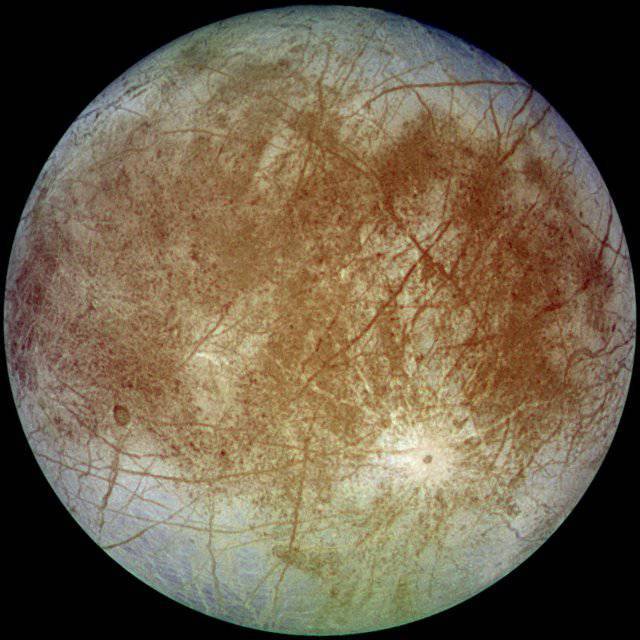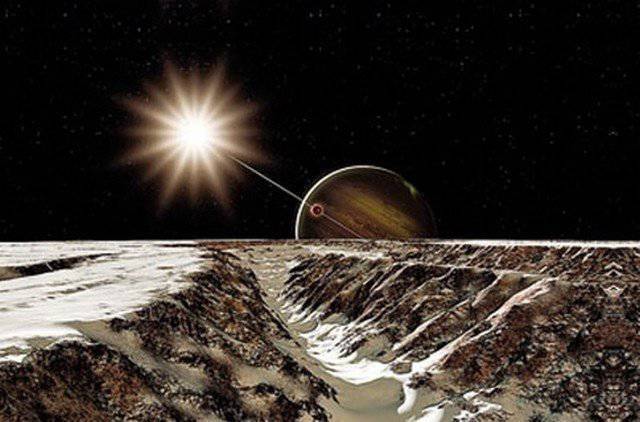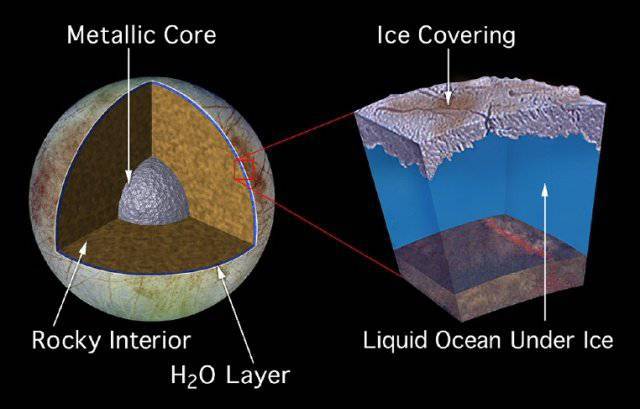NASA may abandon the expedition to Mars and switch to Europe
The earth is simply teeming with various living organisms that are spread all over the planet and are able to survive and adapt to even the most unusual places. At the same time, regardless of the habitat, all living things on Earth have a common feature - they can live where there is water. Without water, there is no life on our planet; there is not a single exception to this rule, no matter what conditions a living organism lives in. This fundamental connection between water availability and life today is at the heart of the search for extraterrestrial life. The presence of water on space objects is a guarantee that humanity can find on them and manifestations of life.
Not so long ago, American astronomers advised NASA to search for extraterrestrial life not on the red planet, but on Europe - the satellite of Jupiter, since there may be an entire ocean. It is on Europe that there is the greatest chance of finding extraterrestrial life forms. It is this satellite that we must study first and foremost, and we already have a mission concept that NASA considers to be realizable. About this on the sidelines of the conference of the American Association for the Advancement of Science told Robert Pappalardo - employee of the NASA Jet Propulsion Laboratory.

Currently, the Laboratory of Applied Physics and the Jet Propulsion Laboratory of the Johns Hopkins University on the instructions of NASA have created a project for a flight to the Jupiter satellite worth 2 billion dollars. According to the scientists, the automatic space station Clipper, which must go into orbit of the gas giant and make several flights around Europe, will have to fly to Europe. So scientists hope to get a global map of the satellite of Jupiter.
If this plan is approved, the Clipper project could be launched as early as 2021. At the same time, the flight of the space station to Jupiter will take from 3 to 6 years. So far, according to Pappalardo, the project is hampered by a lack of funds - earlier NASA made a statement that there was no money for the project to study Jupiter's moon. At the same time, the American space agency has planned to launch a new one to Mars in 2020. Robot, which is similar to what is already working on Mars. At the same time, according to Pappalardo, this strategy is erroneous, because if life once existed on Mars, it disappeared a few billion years ago, but on Europa life can still exist, the scientist believes.
Europe is the sixth satellite of Jupiter, its surface consists of ice, the noticeable youth of which was the reason for the emergence of the hypothesis that there could be an ocean on Europe, and, possibly, life. At the same time in Europe there is a fairly rarefied atmosphere, which consists mainly of oxygen. The satellite of Jupiter has already been investigated several times with the help of automatic probes. In 1979, it was Voyager, and in 1989, it was Galileo.

Europe is somewhat smaller than a single earth satellite. At one time, who discovered him Galileo, named a satellite in honor of the princess of Europe, who was kidnapped by bull Zeus. The diameter of the satellite 3130 km, and the average density of the substance - approximately 3 g / cm 3. The surface of the satellite is covered with water ice. Apparently, under the ice crust there may be a liquid ocean 100 km thick, which covers the silicate core of the satellite. The surface of the satellite is dotted with a network of bright and dark lines, which may be cracks in the ice crust, which have arisen as a result of tectonic processes. Their length can reach several thousand kilometers, and the thickness exceeds 100 kilometers. At the same time, there are almost no craters on the surface of the satellite of Jupiter, which may indicate that the surface of Europe is young - hundreds of thousands or millions of years.
On the surface of Europe, there are no elevations greater than 100 meters, and the estimate of the thickness of the crust ranges from a few kilometers to several tens of kilometers. In addition, in the depths of the satellite it was possible to release the energy of tidal interaction, which maintains the mantle in the liquid state — the under-ice ocean, which may even be warm. Therefore, the possibility of the existence of the simplest forms of life in this ocean is quite real.
Judging by the average density of Europe, silicate rocks should be located under the liquid ocean. In the photographs, which were made in due time by “Galileo”, one can see separate fields having irregular shape and elongated parallel ridges and valleys, which from above look like automobile highways. In a number of places on the surface of Europe one can notice dark spots, which, most likely, are deposits of a substance that was removed from under the ice.

According to the American scientist Richard Greenberg, the conditions for life on the satellite of Jupiter must be sought not in the deep under-ice ocean, but in a large number of cracks. According to him, due to the tidal effect on the satellite, these cracks periodically widen and taper to a width of about 1 meters. At the moment when the crack narrows, the ocean goes down, and at the moment when it expands, the water rises again almost to the surface of the crack. At this time, through a plug of ice that prevents water from reaching the surface, sun rays can penetrate, which carry with it the energy necessary for living organisms.
7 December 1995, the Galileo space station entered the orbit of Jupiter, which allowed scientists to begin unique research on the 4's of its satellites: Ganymede, Io, Calypso and Europe. The conducted magnetometric measurements showed that there are tangible disturbances in Jupiter’s magnetic field near its Calypso and Europe satellites. Apparently, the revealed variations in the magnetic field of the satellites were explained by the presence of an “underground” ocean, which may have a salinity characteristic of the oceans of the Earth. The measurements made suggest that in Europe there is an electrical conductor under the visible surface, while the electric current could not flow through solid ice, which is not a good conductor. At the same time, the gravitational measurements made by Galileo also confirmed the differentiation of the satellite body: the presence of a solid core and ice-water cover with a thickness of up to 100 km.
Currently, many scientists hope to send a scientific mission to Europe, however, as shown storyNASA's budget problems can seriously hinder these plans. So it is not known exactly when humanity will be able to find at least some extraterrestrial form of life in our Universe.
Information sources:
-http: //www.utro.ru/articles/2013/02/18/1101828.shtml
-http: //www.shvedun.ru/jupiter-europa.htm
-http: //zihnata.narod2.ru/zagadki_kosmosa/evropa_sputnik_est_li_zhizn
Information